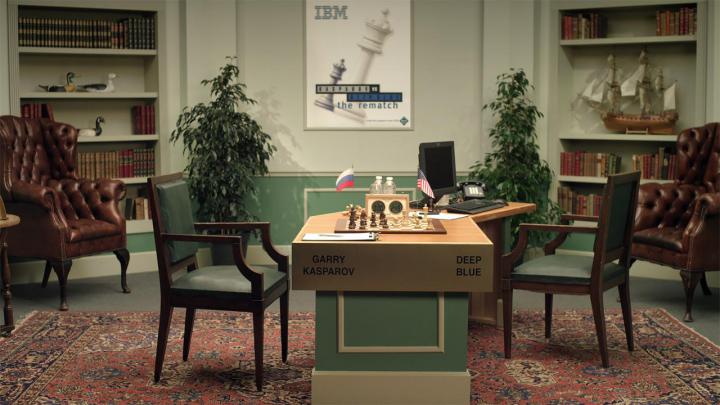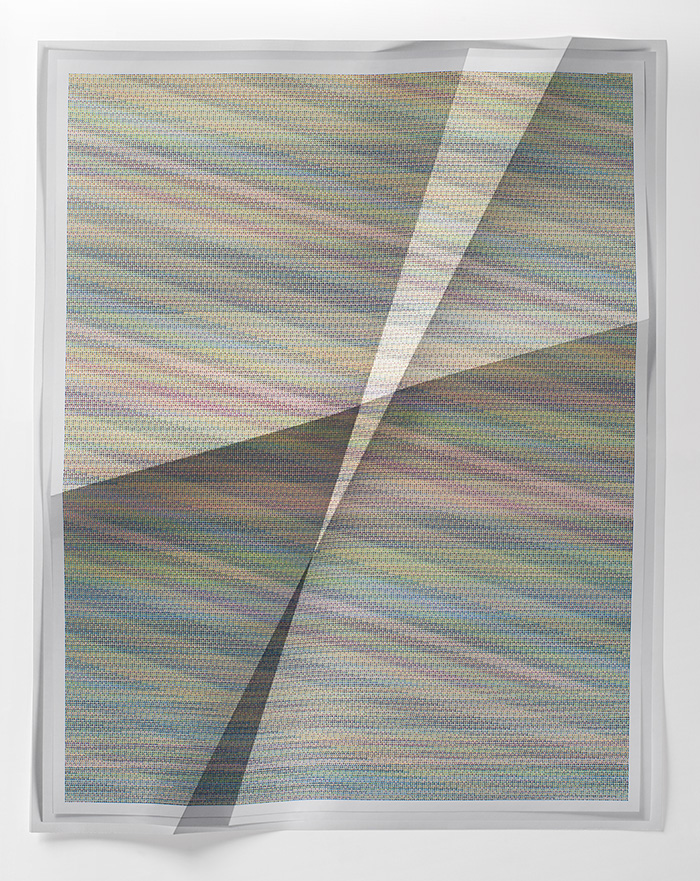
© » KADIST
Natan Lawson
Untitled (Bubbles) by Natan Lawson is produced by a marker with a ball-bearing tip, which is drained and refilled with a new color of acrylic paint for each layer. Untitled (Bubbles) is the result of collaging layers of imagery in the computer, before sending coordinates to the plotter which renders it, with some manual intervention of the canvas. Lawson thinks of the process as related to a computerized jacquard loom, where colors are woven and layered.

© » KADIST
Fabien Giraud & Raphael Siboni
– In whiche a lemyng starre returneth in the yeer foretolde and alle thing that spak to us turneth ayeyn to silence – Sixth episode of The Unmanned and sharing the same camera movements as the episode “1997 – The Brute Force”, “Mil troi cens quarante huyt” refers to the appearance of a comet in 1759 – thus validating the computation and rational prediction of its return by the British astronomer and mathematician Edmond Halley. The action of the film goes back four centuries earlier, in 1348, and unfolds around one unique scene: the escape and the death of a bishop and his court in a forest during the first major outbreak of the Black Plague which was said at the time to be born in the hair of comets.

© » KADIST
Carolina Fusilier
Miercoles cerca de las 7 de la tarde by Caroline Fusilier portrays two quantum computers that are mobile, with human-esque legs, these are systems at the edge of biology. The floor is awash with fluid; perhaps a chemical resource consumed by the advanced computers or a heat-sink. Where their legs meet the fluid there’s a soft glow, less intense but related to the vibrant radiation on the wall above the figures.

© » KADIST
Siavash Naghshbandi
Daily Life of Human is comprised of a fast-paced series of still images selected by the artist from ImageNet, a massive dataset of images (about 14 million) produced by BigGAN. Generative Adversarial Networks, or GANs for short, are AI (machine learning) programs capable of generating (synthesizing, not finding) high-quality images. BigGAN is trained on how to make a certain type of image and then starts producing new images like those it learned from.

© » KADIST
Pascual Sisto
All Watched Over by Machines of Loving Grace takes its title from a 1967 poem by American writer Richard Brautigan, which describes a utopian future where computers are in harmony with and protective of mankind and nature, performing all the necessary work while we retreat back towards nature. In Sisto’s work, a computer generated voice recites Brautigan’s poem while a series of digitally rendered 3D objects with a sleek, mirrored finish, float weightlessly across the screen. Sisto’s work also shares its title with the 2011 BBC documentary series by filmmaker Adam Curtis, which has the view that computers have failed in their task of liberating humanity and have instead created a simplified and distorted world around us.

© » KADIST
John Gerrard
Flag (Thames) 2016 depicts a small section of the Thames River—one that is adjacent to the Palace of Westminster in London—as an algorithmic representation on an LED panel. The river color is vividly represented with reflections of buildings along the riverbank, including Big Ben. At the center of the scene sits a simulated gasoline spill.

© » KADIST
Judith Hopf
Hopf’s works reference the effects that developments in economics and technology have had on our bodily and mental composition. With her series Laptop Men she presents a humorous reading of the way we interact with computers, and the growing tendency to perceive them as part of our bodies. This takes place against a backdrop of an increasing dependence on implants and prostheses among the human species.

© » KADIST
Fabien Giraud & Raphael Siboni
– In which he changes the rules of the game and all imitations are suddenly interrupted – Third episode of The Unmanned series and replicating the editing structure of “1834 – La Mémoire de Masse”, “The Outlawed” takes place in August 1953 on the island of Corfu, in Greece, at the Club Méditerranée resort where Alan Turing spent his last summer. On a sunny afternoon, the mathematician and inventor of the modern computer, subjected to hormonal treatment after being convicted for his homosexuality, embarks on a makeshift raft to study the morphogenesis of marine organisms. As he explores the coast, the raft progressively drifts away.

© » KADIST
Fabien Giraud & Raphael Siboni
– Thisstoryoffriedrichkurzweiliwanttotellit- myselfhowhelivedinthisroomandh – Inspired by the writings of the feral child Kaspar Hauser and told by the young Friedrich, both father and son of Ray Kurzweil, this story unfolds on the microscope images of a blade cutting through metal. Filmed at the scale of a fold of matter, this cut is the axiom on which the first season of The Unmanned rests.

© » KADIST
Fabien Giraud & Raphael Siboni
-In which predicting its past it lives working and dies fighting- Fifth episode of The Unmanned , “La Mémoire de Masse” unfolds during the second Canuts revolts in Lyon in 1834. These riots now known as the ‘bloody week’ came as a reaction to the automation of work in the silk industry by the Jacquard Loom and its implementation of the punched card – first historical ‘mass storage’ system allowing the inscription and replication of complex weaving patterns. This inaugurating event in the history of workers emancipation movements of the 19th century is actually the first revolt against modern computation.

© » KADIST
Fabien Giraud & Raphael Siboni
– In which defeated he leaves the scene and the stage is left in search of its scale – Second episode of The Unmanned series, “The Brute Force” reconstructs the minutes following Garry Kasparov’s defeat against the IBM Deep Blue computer on 11 May 1997. A camera with computer-programmed movements scrutinises the elements of an empty setting after the chess champion has left the scene, thus abandoning it to the disproportion of a world without its own scale.

© » KADIST
John Houck
Untitled #242 is part of Houck’s Aggregates Series, which uses digital tools to manipulate chosen sets and pairs of colors, creating colorful index sheets, bathed in colors and lines. Houck transforms these simple outputs physically, folding, lighting, photographing, and re-printing them, only to fold, photograph, and re-print again. An MFA graduate from UCLA, John Houck works primarily in the medium of photography and specializes in still-life vignettes.
Fabien Giraud & Raphael Siboni
The collaborative work of Fabien Giraud and Raphael Siboni is part of a reflection on the history of cinema, science, and technology...
Siavash Naghshbandi
Siavash Naghshbandi has long been interested in computer systems and the approaching horizon of Artificial Intelligence...
Judith Hopf
In her sculptures, installations and videos, German artist Judith Hopf transforms everyday settings and humble materials into comic expressions of humanist values, verging on the absurd...
John Houck
- year born: 1977
- gender: male
- nationality: American
- home town: South Dakota
Carolina Fusilier
Caroline Fusilier’s paintings are dark, foreboding, and ominous...
Natan Lawson
Producing hybrid artworks at the intersection of drawing and painting, Natan Lawson’s work exists in between hand-made and computer-processed...
Pascual Sisto
Artist and filmmaker Pascual Sisto is known for creating works that reimagine the mundane as captivating alternate realities...
John Gerrard
For more than two decades, John Gerrard has produced media work that has harnessed the emergent technologies of programming languages and gaming engines, and transmuted them into landscapes and portraits of ever increasing intricacy and autonomy...
-
2010-2019
Pascual Sisto
2013All Watched Over by Machines of Loving Grace takes its title from a 1967 poem by American writer Richard Brautigan, which describes a utopian future where computers are in harmony with and protective of mankind and nature, performing all the necessary work while we retreat back towards nature...
John Houck
2013Untitled #242 is part of Houck’s Aggregates Series, which uses digital tools to manipulate chosen sets and pairs of colors, creating colorful index sheets, bathed in colors and lines...
Fabien Giraud & Raphael Siboni
2014– In which he changes the rules of the game and all imitations are suddenly interrupted – Third episode of The Unmanned series and replicating the editing structure of “1834 – La Mémoire de Masse”, “The Outlawed” takes place in August 1953 on the island of Corfu, in Greece, at the Club Méditerranée resort where Alan Turing spent his last summer...
Fabien Giraud & Raphael Siboni
2014– Thisstoryoffriedrichkurzweiliwanttotellit- myselfhowhelivedinthisroomandh – Inspired by the writings of the feral child Kaspar Hauser and told by the young Friedrich, both father and son of Ray Kurzweil, this story unfolds on the microscope images of a blade cutting through metal...
Fabien Giraud & Raphael Siboni
2014– In which defeated he leaves the scene and the stage is left in search of its scale – Second episode of The Unmanned series, “The Brute Force” reconstructs the minutes following Garry Kasparov’s defeat against the IBM Deep Blue computer on 11 May 1997...
Fabien Giraud & Raphael Siboni
2015-In which predicting its past it lives working and dies fighting- Fifth episode of The Unmanned , “La Mémoire de Masse” unfolds during the second Canuts revolts in Lyon in 1834...
John Gerrard
2016Flag (Thames) 2016 depicts a small section of the Thames River—one that is adjacent to the Palace of Westminster in London—as an algorithmic representation on an LED panel...
Fabien Giraud & Raphael Siboni
2017– In whiche a lemyng starre returneth in the yeer foretolde and alle thing that spak to us turneth ayeyn to silence – Sixth episode of The Unmanned and sharing the same camera movements as the episode “1997 – The Brute Force”, “Mil troi cens quarante huyt” refers to the appearance of a comet in 1759 – thus validating the computation and rational prediction of its return by the British astronomer and mathematician Edmond Halley...
Judith Hopf
2018Hopf’s works reference the effects that developments in economics and technology have had on our bodily and mental composition...
Siavash Naghshbandi
2019Daily Life of Human is comprised of a fast-paced series of still images selected by the artist from ImageNet, a massive dataset of images (about 14 million) produced by BigGAN...
-
2020-2029
Carolina Fusilier
2023Miercoles cerca de las 7 de la tarde by Caroline Fusilier portrays two quantum computers that are mobile, with human-esque legs, these are systems at the edge of biology...


